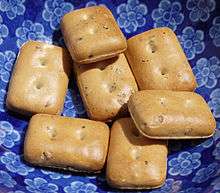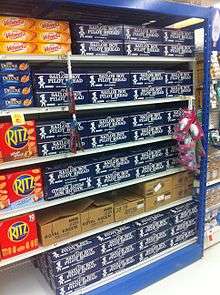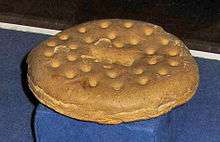Hardtack
|
A preserved hardtack at a museum display | |
| Alternative names | ANZAC wafers, brewis, cabin bread, dog biscuit, hard tack, molar breakers, pilot bread, sea biscuit, sea bread, sheet iron, ship's biscuit, shipbiscuit, tooth dullers, worm castles |
|---|---|
| Type | Cracker or biscuit |
| Main ingredients | Flour, water |
|
| |
Hardtack (or hard tack) is a simple type of biscuit or cracker, made from flour, water, and sometimes salt. Inexpensive and long-lasting, it was and is used for sustenance in the absence of perishable foods, commonly during long sea voyages, land migrations, and military campaigns.[1] The name derives from the British sailor slang for food, "tack". It is known by other names such as brewis (possibly a cognate with "brose"), cabin bread, pilot bread, sea biscuit, sea bread (as rations for sailors), ship's biscuit, or ship biscuit, or pejoratively as "dog biscuits", "molar breakers", "sheet iron", "tooth dullers", or "worm castles".[2] Australian and New Zealand military personnel knew them with some sarcasm as ANZAC wafers (not to be confused with Anzac biscuit).
History
The introduction of the baking of processed cereals, including the creation of flour, provided a more reliable source of food. Egyptian sailors carried a flat brittle loaf of millet bread called dhourra cake, while the Romans had a biscuit called bucellatum. King Richard I of England left for the Third Crusade (1189–92) with "biskit of muslin", which was a mixed grain compound of barley, bean flour, and rye.[3]
Some early physicians associated most medical problems with digestion. Hence, for sustenance and health, eating a biscuit daily was considered good for one's constitution. The bakers of the time made biscuits as hard as possible, as the biscuits would soften and become more palatable with time due to exposure to humidity and other weather elements.[4] Because it is so hard and dry, hardtack (when properly stored and transported) will survive rough handling and temperature extremes. The more refined captain's biscuit was made with finer flour.
To soften, hard tack was often dunked in brine, coffee, or some other liquid, or cooked into a skillet meal. Baked hard, it would stay intact for years if kept dry. For long voyages, hardtack was baked four times, rather than the more common two, and prepared six months before sailing.[5]
In 1588, the daily allowance on board a Royal Navy ship was one pound of biscuits plus one gallon of beer. Later, Samuel Pepys in 1667 first regularized naval victualing with varied and nutritious rations. Royal Navy hardtack during Queen Victoria's reign was made by machine at the Royal Clarence Victualing Yard at Gosport, Hampshire, stamped with the Queen's mark and the number of the oven in which it was baked. Biscuits remained an important part of the Royal Navy sailor’s diet until the introduction of canned foods; canned meat was first marketed in 1814, and preserved beef in tins was officially introduced to the Royal Navy rations in 1847.[3]
Ship's biscuit, crumbled or pounded fine and used as a thickener, was a key ingredient in New England seafood chowders from the late 1700s.[6]
In 1801, Josiah Bent began a baking operation in Milton, Massachusetts, selling "water crackers" or biscuits made of flour and water that would not deteriorate during long sea voyages from the port of Boston, which was also used extensively as a source of food by the gold prospectors who migrated to the gold mines of California in 1849. Since the journey took months, pilot bread, which could be kept a long time, was stored in the wagon trains. Bent's company later sold the original hardtack crackers used by troops during the American Civil War. The G. H. Bent Company remains in Milton and continues to sell these items to Civil War re-enactors and others.
During the American Civil War (1861–65), three-inch by three-inch (7.5 cm by 7.5 cm) hardtack was shipped from Union and Confederate storehouses. Some of this hardtack had been stored from the 1846–48 Mexican–American War. With insect infestation common in improperly stored provisions, soldiers would break up the hardtack and drop it into their morning coffee. This would not only soften the hardtack but the insects, mostly weevil larvae, would float to the top, and the soldiers could skim off the insects and resume consumption.[7] Some men also turned hardtack into a mush by breaking it up with blows from their rifle butts, then adding water. If the men had a frying pan, they could cook the mush into a lumpy pancake; otherwise they dropped the mush directly on the coals of their campfire. They also mixed hardtack with brown sugar, hot water, and sometimes whiskey to create what they called a pudding, to serve as dessert.[8]
During the Spanish–American War, some military hardtack was stamped with the phrase "Remember the Maine".[9]
Modern use




Commercially available pilot bread is a significant source of food energy in a small, durable package. A store-bought 24-gram cracker can contain 100 kilocalories (20 percent from fat), 2 grams of protein and practically no fibre.
Asia
Ma Bo mentioned hardtack as being a staple food of Chinese hard-labor workers in Inner Mongolia, during the Cultural Revolution.[10]
Hardtack was a staple of military servicemen in Japan and South Korea well into the late 20th century. It is known as Katapan (堅パン) in Japan and geonbbang(=geonppang) (건빵) in South Korea, meaning 'dry bread', and is still sold as a fairly popular snack food in both countries. (Canned kanpan is also distributed in Japan as emergency rations in case of earthquake, flood, or other disaster.[11]) A harder hardtack than Kanpan, called Katapan (堅パン), is historically popular in Kitakyushu City, Fukuoka, Japan as one of its regional specialty foods.[12] In Korea, geonppang (hardtacks) mixed with konpeito as a medley is considered a popular snack.
Europe
British and French re-enactors buy or bake hardtack, as do Americans.[13]
In Genoa, hardtack was and still is a traditional addition to a fish and vegetable salad called cappon magro.
Hardtack, baked with or without the addition of fat, was and still is a staple in Russian military rations, especially in the Navy, as infantry traditionally preferred simple dried bread when long shelf life was needed. Called galeta (галета) in Russian, it is usually somewhat softer and more crumbly than traditional hardtack, as most varieties made in Russia include at least some fat or shortening, making them closer to saltine crackers. One such variety, khlyebtsy armyeyskiye (хлебцы армейские), or "army crackers", is included in Russian military rations. Other brands enjoy significant popularity among the civilian population as well, both among campers and the general populace.
Melanesia
Hardtack remains hugely popular today in Papua New Guinea. The Lae Biscuit Company, which is the most commonly found and popular brand in that country, makes the Snax line of flavored hardtack for general popular consumption, the no-frills Cabin line, which is probably as close as can be found to the original hardtack as carried by British ships, and the Navy line, which combines the wooden-like consistency of the Cabin line with a powerful MSG-rich flavoring.
North America
Canada
Hardtack is a mainstay in parts of Canada. Canawa is one Canadian maker of traditional hardtack. They specialize in a high density, high caloric product that is well suited for use by expeditions.
Purity Factories, located in St John's, Newfoundland, currently bakes three varieties of hardtack:
- The first variety, a cracker similar to a cross between an unsalted saltine and hardtack, is the "Crown Pilot Cracker". It was a popular item in much of New England and was manufactured by Nabisco until it was discontinued in the first quarter of 2008. It was discontinued once before, in 1996, but a small uprising by its supporters brought it back in 1997. This variety comes in two sub-varieties, Flaky and Barge biscuits.
- The second is Hard Bread, a traditional hardtack, and is the principal ingredient in fish and brewis, a traditional Newfoundland and Labrador meal.
- The third variety is Sweet Bread, which is slightly softer than regular hardtack due to a higher sugar and shortening content, and is eaten as a snack food.
United States
Interbake Foods of Richmond, Virginia, produces most, if not all, of the commercially available hardtack in the United States, under the "Sailor Boy" label. As of January 2015, 98 percent of its production goes to Alaskans.
Alaskans are among the last to still eat hardtack (Iñupiaq: qaqqulaq, Central Alaskan Yup'ik: suggʼaliq, Tlingit g̱aatl) as a significant part of their normal diet. Originally imported as a food product that could endure the rigours of transportation throughout Alaska, pilot bread has become a favoured food even as other, less robust foods have become available. Alaskan law requires all light aircraft to carry "survival gear", including food. Therefore, the blue-and-white Sailor Boy Pilot Bread boxes are ubiquitous at Alaskan airstrips, in cabins, and in virtually every village. Unlike the traditional hardtack recipe, Sailor Boy Pilot Bread contains leavening and vegetable shortening.[14] Alaskans enjoy warmed pilot bread with melted butter or with soup or moose stew. Pilot bread with peanut butter, honey, or apple sauce is often enjoyed by children.
Hardtack is also a common pantry item in Hawaii, and The Diamond Bakery's "Saloon Pilot" cracker is available there in grocery and sundry stores. The round hardtack crackers are available in large- and small-diameter sizes.
Those who buy commercially baked pilot bread in the continental US are often those who stock up on long-lasting foods for disaster survival rations. Hardtack can comprise the bulk of dry food storage for some campers. Pilot bread, sometimes referred to as pilot crackers in advertising, is often sold in conjunction with freeze-dried foods as part of package deals by some survival food companies.
Many other people who currently buy or bake hardtack in the US are Civil War re-enactors.[13] One of the units that continually bakes hardtack for living history is the USS Tahoma Marine Guard Infantry of the Washington State Civil War Association.
See also
- G. H. Bent Company, Bent's Cookie Factory were purveyors of "water crackers" and hardtack during the American Civil War
- Cracker (food)
- Cram and lembas in J. R. R. Tolkien's Middle-earth books are modeled after hardtack
- Cream cracker
- Crisp bread
- List of breads
- List of crackers
- Matzo
- Rusk
- Saltine cracker
- Water biscuit
References
- ↑ "Hardtack". KenAnderson.com.
- ↑ "19th United States Infantry". 19thusregulars.com. Retrieved 2013-12-25.
- ↑ "HM Customs&Excise – differentiation of cakes and biscuits".
- ↑ "Hardtack". Cyclopaedia, or an Universal Dictionary of Arts and Sciences.
- ↑ John Thorne and Matt Lewis Thorne, Serious Pig: An American Cook in Search of His Roots. New York: Farrar, Straus and Giroux. 1996. pp.163–166.
- ↑ "Hardtack". Kenanderson.net. Retrieved 2010-08-13.
- ↑ "Hardtack Is Easy to Make, Hard to Eat". The Washington Post. December 12, 2004. Retrieved November 24, 2013.
- ↑ "Spanish American Hardtack". BexleyHistory.org. Retrieved 2012-05-28.
- ↑ Ma, Bo; Goldblatt, Howard (transl.) (1995). Blood Red Sunset. Viking Penguin. ISBN 0-14-015942-8.
- ↑ ja:非常食
- ↑ ja:堅パン Katapan from Wikipedia
- 1 2 Olustee Battlefield Reenactment Everything from bacon and hardtack. Retrieved 2008-10-23.
- ↑ Robertson, Gary Robertson. "Northern Exposure: A Henrico firm's hardtack cracker has become a cultural staple for Alaskans". Henrico Monthly. Retrieved January 8, 2015.
![]() This article incorporates text from a publication now in the public domain: Chambers, Ephraim, ed. (1728). "article name needed". Cyclopædia, or an Universal Dictionary of Arts and Sciences (first ed.). James and John Knapton, et al.
This article incorporates text from a publication now in the public domain: Chambers, Ephraim, ed. (1728). "article name needed". Cyclopædia, or an Universal Dictionary of Arts and Sciences (first ed.). James and John Knapton, et al.
Further reading
- Layinka Swinburne (1997). "Dancing with the Mermaids: Ship's Biscuit and Portable Soup". In Harlan Walker. Food on the Move: Proceedings of the Oxford Symposium on Food and Cookery, 1996. Prospect Books. ISBN 978-0-907325-79-6.
External links
| Wikimedia Commons has media related to Hardtack. |
| Wikibooks Cookbook has a recipe/module on |
![]() Food portal
Food portal

